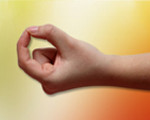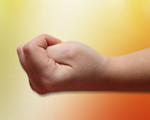There is much more to yoga than meets the eye. While the practice of yoga means asanas and breathing practices to many, there is a lesser-known, subtler, and independent branch of yoga: Yog Tatva Mudra Vigyan, or the science of yoga mudra and pranayama.
Quick glance Mudras in Yoga
Significance of yoga mudra
Entirely distinct and based on the principle of Ayurveda, yoga mudras are understood as a healing modality. The Sanskrit word mudra is translated as a gesture. A mudra may involve the whole body or could be a simple hand position. Mudras used in combination with pranayamas enliven the flow of prana in the body, thereby energizing different parts of the body.
How do yoga mudra work?
According to Ayurveda, diseases are caused due to an imbalance in the body, which in turn is caused by lack or excess of any of the five elements.
Our fingers have the characteristics of these elements, and each of these five elements serves a specific and important function within the body. The fingers are essentially electrical circuits. The use of mudras adjusts the flow of energy – affecting the balance of air, fire, water, earth, ether – and facilitate healing.
Hand Mudras create a subtle connection with the instinctual patterns in the brain and influence the unconscious reflexes in these areas. The internal energy is, in turn, balanced and redirected, affecting change in the sensory organs, glands, veins, and tendons.Yoga mudras are practiced by sitting cross-legged in Vajrasana or in the Lotus Pose, or even by sitting comfortably on a chair. Ideally, Ujjayi breathing is done when practicing most mudras. Take at least twelve breaths in each yoga mudra and closely observe the flow of energy in the body.
Types of Yoga Mudras, Pranayama Benefits & How to Do

- Hold the thumb and index finger together lightly while extending the remaining three fingers.
- The thumb and index finger need only touch together, without exerting any pressure.
- Keep the three extended fingers as straight as possible.
- The hands can then be placed on the thighs, facing upwards.
- Now, observe the flow of breath and its effect.
Benefits of Chin Mudra
- Better retention and concentration power.
- Improves sleep pattern.
- Increases energy in the body.
- Alleviates lower backache.

- In this mudra, the thumb and forefinger form a ring, and the three remaining fingers are curled into the palms of the hands.
- Again, the hands are placed on the thighs with palms facing upwards, and deep comfortable Ujjayi breaths are taken.
- Once more, observe the flow of breath and its effect.
Benefits of Chinmaya Mudra
- Improves the flow of energy in the body.
- Stimulates digestion.

- In Adi Mudra, the thumb is placed at the base of the small finger, and the remaining fingers curl over the thumb, forming a light fist.
- The palms are again placed facing upwards on the thighs and the breathing is repeated.
Benefits of Adi Mudra
- Relaxes the nervous system.
- Helps reduce snoring.
- Improves the flow of oxygen to the head.
- Increases capacity of the lungs.
- Place both the hands in Adi Mudra, with the knuckles touching each other.
- Tuck the hands near the navel area with the fingers facing upwards.
- Observe the flow of breath.
Learn how to treat your mind, body, and emotions with the processes taught in The Art of Living Meditation and Breath workshop. This is your complete healthcare package.
Practicing Yoga helps develop the body and mind, yet is not a substitute for medicine. It is essential to learn and practice yoga under the supervision of a trained Yoga teacher. In case of any medical condition, practice yoga only after consulting your doctor and a Sri Sri Yoga teacher.
FAQ's on Yoga Mudra Pranayama
Ayurveda says, imbalance of the five elements of universe causes disease. Our thumb represents fire element, index finger denotes air, middle finger is for space, ring finger is for earth, and little finger is for water.
In Sanskrit mudra is a gesture involving the whole body or a simple hand position. Breathing techniques in combination with mudra stimulates the prana flow in the body. Mudras at your fingertips generates a subtle connection with the brain patterns and controls the reflexes pertaining to the area to be affected like organs, glands, veins, etc.
"Anjali Mudra has a significant role in harmonising the right and left hemispheres of the brain. Improves circulation of oxygen in blood. While balancing the pituitary and adrenal glands, increases your intuitive power. Your arms and wrists become better flexible. You are able to deal with emotions better. Stimulates memory power. "
"Depending up on the specific needs channelise the pranic flow in following powerful mudras: Chin mudra for concentration power Chinmaya mudra for digestion Adi mudra reduce snoring and relaxes nervous system Brahma mudra reduces tiredness Anjali mudra for positive thoughts Prana Mudra facilitates healing Varun mudra for clarity in communication Apan Vayu mudra for stress relief Surya mudra for better metabolism Ashwini mudra for constipation Hakini mudra for the mind "
Yes, yoga mudra is effective. The fingertips of your hands are having a strong connection with your brain through the neural activation. Each mudra acts as a bond in aligning the energy associated with the mudra.
Prithvi Mudra (brings strength and settles mind), Prana Mudra (vitality), Ganesh Mudra (removal of obstacles), Anjali mudra (for peace), Kali Mudra (overcome difficulty) and Linga Mudra is for strengthening the lungs and overcomes respiratory problems.
When finger tips and fingers are positioned in a posture or gesture (bend, overlap, touch) - a powerful yoga mudra, the electrical circuit gets stimulated and the brain is energized. The signal recieved by the brain helps in changing the energy pattern in the body, mind, emotions.
Interested in yoga classes?



